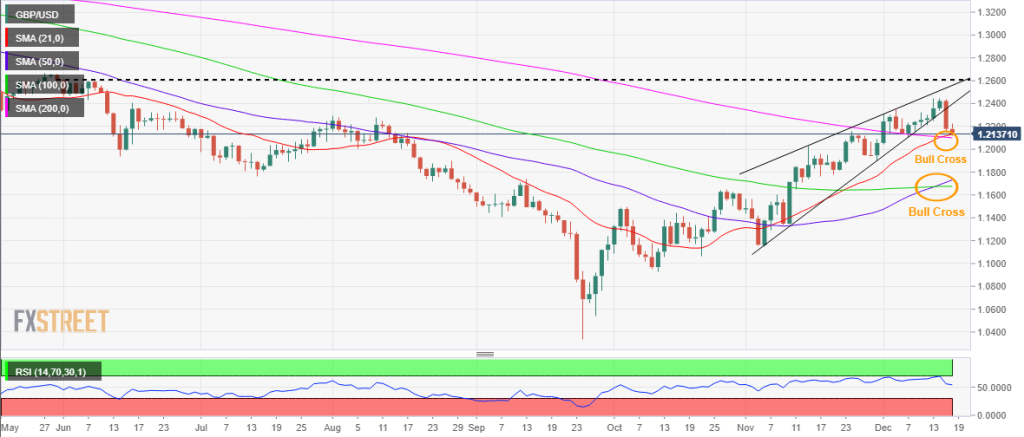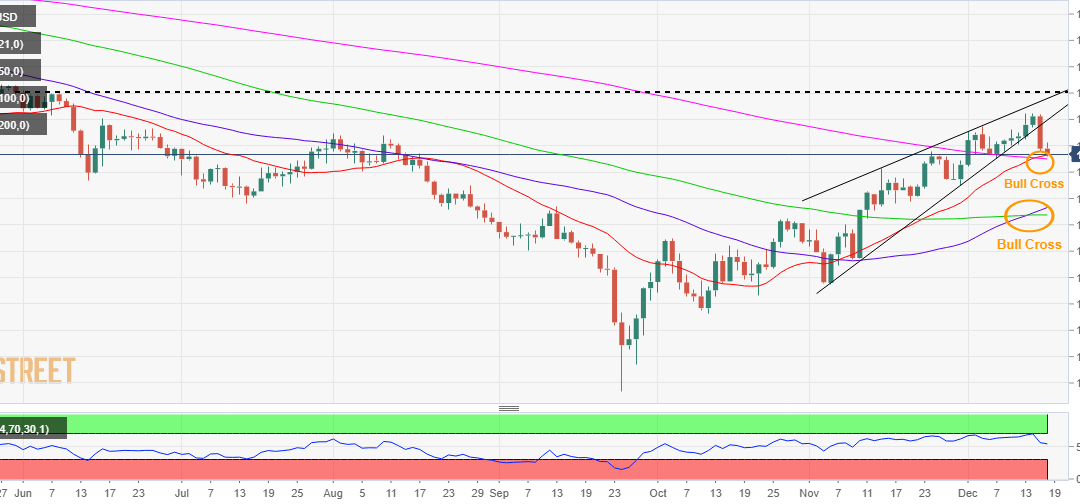- GBP/USD settled second straight week in the red, following a new six-month top.
- Hawkish Federal Reserve saves the day for the United States Dollar.
- Dual bullish crossovers on the daily chart keep GBP/USD buyers hopeful.
GBP/USD reversed sharply from a six-month top and ended the week marginally lower amid a bumper week for central bank activity, which brought the US Federal Reserve (Fed) and the Bank of England (BoE) monetary policy divergence back to the fore. Investors now shift their attention toward the last full week of 2022, eyeing the top-tier United States economic data amid a relative quiet docket for the United Kingdom.
GBP/USD hurt by Fed-BoE contrast
The Pound Sterling enjoyed good two-way businesses in the busiest week heading into the Xmas and New Year holidays. The main underlying theme that influenced the GBP/USD pair was the continuing widening policy divergence between the Federal Reserve and the Bank of England, which re-emerged in the second part of the week. But in the first half, a broad-based United States Dollar sell-off powered the British Pound to the highest level in six months just shy of the 1.2450 psychological level.
In anticipation of the critical United States Consumer Price Index (CPI) on Tuesday, GBP/USD failed to garner much bullish impetus despite the upbeat United Kingdom Gross Domestic Product (GDP) data amid a mixed market mood, which offered some comfort to the US Dollar buyers. The UK Gross Domestic Product release showed on Monday that the economy returned to a 0.5% expansion in October vs. -0.1% expected and -0.6% previous.
Cable buyers paid a little heed to the mixed United Kingdom labor market data on Tuesday, as all eyes remained focused on the US Consumer Price Index data. The UK’s Office for National Statistics (ONS) showed the ILO Unemployment Rate rose to 3.7% in three months to October from 3.6% in September, as expected. The Average Earnings Including Bonus rose by 6.1% on a yearly basis in the same period. The number of people claiming jobless benefits in the United Kingdom leaped by 30.5K in November when compared to -6.4K booked previously.
The tide turned against the US Dollar bulls after the United States US Consumer Price Index, a closely-watched measure of inflation, jumped 7.1% from a year ago, down from 7.7% in October. On a monthly basis, the Consumer Price Index rose just 0.1% in November, down from 0.4% in October. The Core CPI prints across the time horizon also cooled down, implying that the Federal Reserve terminal rate is unlikely to go above the 5% level. Fed fund futures then pointed to a peak rate of 4.86% by May 2023. The US Treasury bond yields plunged, as the US Consumer Price Index fed into the ‘Fed pivot’ narrative.
But to the market’s surprise US Federal Reserve Chairman Jerome Powell’s tough talking on inflation on Wednesday, suggested “I wouldn’t see us considering rate cuts until the committee is confident that inflation is moving down to 2%,” watering down expectations of a ‘Fed pivot.’ The Federal Reserve raised its target rate by 50 basis points (bps) to 4.25%-4.50%, as widely expected but delivered a hawkish surprise by raising the terminal rate to 5.1% by the end-2023 vs. 4.6% projected in September. In response, the United States Dollar rebounded firmly and extended its recovery momentum into the balance of the week, as expectations of higher interest rates for longer amplified recession fears and rattled risk sentiment.
Downbeat Chinese Retail Sales and Industrial Production data added to the gloomy economic backdrop worldwide, supporting the renewed US Dollar buying. Thursday’s dovish Bank of England rate hike allowed the USD bulls to hold the upper hand, as the British central bank hiked rates by 50 bps to 3.50% (as expected) but refrained from committing to more amid a divided vote split. Two of the nine Bank of England policymakers, Silvana Tenreyro and Swati Dhingra, voted to keep rates unchanged at 3.0%. Uncertainty around the Bank of England policy outlook smashed the Pound Sterling against the US Dollar, as the GBP/USD pair tested bullish commitments at around 1.2150 once again.
On Friday, investors remained on the sidelines, as the dust settled after the various central bank meetings. GBP/USD extended the weakness amid the end-of-the-week flows, downbeat United Kingdom’s Retail Sales data and mixed S&P Global Preliminary Manufacturing and Services PMIs. The UK retail sales dropped 0.4% over the month in November vs. 0.3% expected and 0.9% previous. The core retail sales, stripping the auto motor fuel sales, fell by 0.3% MoM vs. 0.3% expected and 0.7% previous. The seasonally adjusted S&P Global/CIPS UK Manufacturing Purchasing Managers’ Index (PMI) dropped further to 44.7 in December versus 46.3 expected and 46.5 – in November’s final reading. Meanwhile, the Preliminary UK Services Business Activity Index for December arrived at 50.00 when compared to November’s final print of 48.8 and 48.5 expected.

United States PCE inflation in the spotlight
With the central banks’ heavy week over, investors could take it easy at the start of the week, in absence of any high-impact data from both sides of the Atlantic. The United Kingdom CBI Industrial Order Expectations will entertain Pound Sterling traders on Monday.
The United States Building Permits and Housing Starts data will be published on Tuesday amid a lack of news from the United Kingdom. Wednesday will see the UK CBI Realized Sales and US CB Consumer Confidence data amongst other minority data from the United States.
The Final Gross Domestic Product releases from the United States and the United Kingdom will drop on Thursday but is unlikely to have any market impact. Therefore, investors will eagerly look forward to a fresh batch of data publications from the United States on Friday, including the Federal Reserve’s preferred inflation gauge, the Core PCE Price Index, and the Durable Goods Orders. The revised University of Michigan (UoM) Consumer Sentiment and Inflation Expectations data will also offer some trading incentives at the end of a relatively quiet week.
GBP/USD technical outlook

GBP/USD: Daily Chart
Having confirmed a downside break from the Rising Wedge formation on Thursday, GBP/USD found support near mid-1.2100s, just above the bullish 21-Daily Moving Average (DMA) at 1.2134.
Despite the rising wedge breakdown, risks remain skewed to the upside for the Pound Sterling bulls, as the daily technical setup paints a bullish picture in the near term.
First, the 14-day Relative Strength Index (RSI) keeps its hold above the midline even after the recent downtrend.
Second, the daily sticks display a double Bull Cross, with the 21DMA cutting the 200DMA from below and the 50DMA piercing the 100DMA for the upside.
Therefore, GBP bulls will need to defend the 1.2100-1.2135 demand area to negate the bearish thesis. The descending 200DMA aligns at 1.2100.
A sustained move below the latter will trigger a fresh downswing toward the bullish 50DMA at 1.1773. The horizontal 100DMA at 1.1675 could be next on the sellers’ radars.
On the upside, the wedge support-turned-resistance at 1.2415 will be a tough nut to crack for GBP/USD buyers. Acceptance above the latter will open doors toward the six-month high at 1.2446.
The next critical resistance is envisioned at the 1.2500 round figure, above which the horizontal trendline resistance at 1.2599 will come into play.

